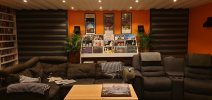I hope your constructor have good understanding of proper acoustic treatment and drywall building, because in ordinary empty rectangular room of such size typical RT in lows can easily reach 2000 msec. With nasty vibration of drywall and modal issues simultaneously.nothing but concrete and dry wall when finished. Instead of covering the surfaces with soft material, I am considering just apply treatment as is.
In theory, if your room is made according to RFZ concept, you can use zero open porous absorption, but your picture don't look like standard RFZ...


